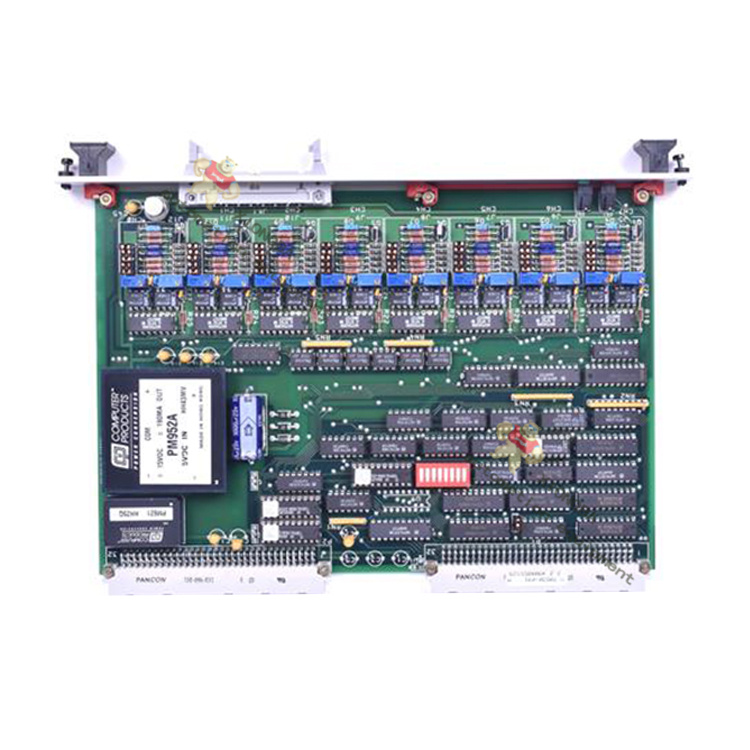Basic information
Product model: XVME-530
Part number: 70530-001
Version: FREV 2.2L
Bus standard: VME bus, compliant with VITA 1.1 standard, ensuring compatibility and interoperability with other VME devices.
Output channel
Number of channels: 16 analog output channels, capable of controlling multiple devices or actuators simultaneously.
Output type: voltage output or current output, users can choose through software or hardware configuration.
Electrical characteristics
Voltage output range: Multiple options including ± 10V, 0-10V, ± 5V, 0-5V, etc., to meet the needs of different application scenarios.
Current output range: 4-20mA, 0-20mA, suitable for long-distance transmission and situations with high requirements for driving load capacity.
Resolution: 12 bits, capable of providing high output accuracy to ensure control accuracy.
Establishment time: The typical value is 25 μ s to ensure rapid response to system output changes.
Output accuracy: At room temperature (25 ℃), the voltage output accuracy is ± 0.1% FSR (full range), and the current output accuracy is ± 0.2% FSR; Within the working temperature range (-40 ℃ -+85 ℃), the voltage output accuracy is ± 0.3% FSR, and the current output accuracy is ± 0.5% FSR.
Interface and Communication
Interface type: DB37 connector, used to connect external devices and sensors.
Communication protocol: Communicate with the host through the VME bus, support standard VME data transmission protocol, and achieve fast data exchange.
Work environment
Working temperature: -40 ℃ -+85 ℃, able to adapt to harsh industrial environments.
Storage temperature: -55 ℃ -+125 ℃.
Humidity: 5% -95% (no condensation), ensuring normal operation in humid environments.
Power requirements
Working voltage:+5V DC, typical current consumption is 350mA;+15V DC, typical current consumption is 35mA; -15V DC, typical current consumption is 30mA.
mechanical properties
Size: Complies with the VME 6U standard size, making it easy to install in a VME chassis.
Weight: Approximately 500 grams (subject to actual product).
Core functions
Multi channel independent output
16 analog output channels can be independently configured as voltage or current output modes, supporting mixed use of different signal ranges, suitable for collaborative control of multiple actuators in complex industrial control systems.
Dynamic output update
Supports single channel or multi-channel synchronous updates, and can quickly refresh output values through the VME bus to meet real-time control requirements. For example, in robot motion control, synchronous motion control of multiple joints can be achieved.
Output protection mechanism
Short circuit protection: automatically limits the current when the output terminal is short circuited to prevent module damage
Overvoltage protection: Built in limiting circuit to prevent output voltage from exceeding the safe range
Thermal shutdown protection: automatically shuts off the output when the temperature exceeds the threshold, and automatically restarts after the temperature is restored
Fault diagnosis function
Output status monitoring: Real time detection of whether the output of each channel is normal
Sensor disconnection detection: supports detecting the connection status of external loads
Fault code storage: Record recent fault information for easy maintenance
Working principle
The XVME-530 module is based on digital to analog conversion (DAC) technology to achieve signal conversion. The workflow is as follows:
Data reception: Receive digital control signals (12 bit binary values) sent by the host through the VME bus
Data cache: The received data is temporarily stored in registers inside the module
DAC conversion: Digital signals are converted into analog voltage/current signals through high-precision DAC converters
Signal conditioning: The converted analog signal is processed by amplification, filtering, and other conditioning circuits to ensure the stability and accuracy of the output signal
Output driver: The conditioned signal is transmitted to the external load through the output driver circuit
The module adopts optoelectronic isolation technology internally to achieve isolation between digital circuits and analog circuits, effectively suppressing electromagnetic interference, improving anti-interference ability and system reliability.
Precautions
Installation and wiring
It needs to be installed in a metal chassis that meets EMC standards, ensuring good grounding
Analog signal lines should be wired separately from digital signal lines to avoid cross interference
Suggest using shielded cables to connect external devices, with the shielding layer grounded at one end
Power requirements
The power supply needs to be stable, and the ripple coefficient should be less than 50mV
Each power pin should be connected according to regulations to avoid reverse connection or short circuit
It is recommended to use an independent power supply to power the module and avoid sharing power with high load devices
Configuration and Programming
Before first use, it is necessary to initialize and configure the output mode, range, and other parameters through software
When programming, attention should be paid to the correctness of data format and register addresses
Avoid frequent reading and writing of module registers to prevent data conflicts
Environmental adaptability
Avoid using in environments with strong magnetic or electric fields
The working environment should be well ventilated to avoid dust accumulation
When used in high humidity environments, moisture-proof measures should be taken



Leave a comment
Your email address will not be published. Required fields are marked *